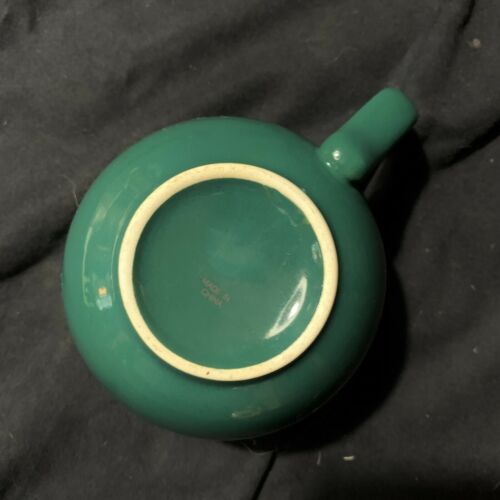-40%
Vintage Marshall Field’s Department Store Soup/Coffee Mug
$ 26.4
- Description
- Size Guide
Description
Vintage Marshall 16 ounce Field’s Department StorePottery
Soup/Coffee Mug -- Familiar dark green store color with 24 ct. gold imprinting with store name and famous clock logo.
Marshall Field's
(officially
Marshall Field & Company
) was a
department store
in
Chicago
,
Illinois
, founded in the 19th century that grew to become a large chain before being acquired by
Macy's, Inc
in 2005. The former flagship
Marshall Field and Company Building
location on
State Street
in the
Loop
of downtown Chicago was officially renamed
Macy's
on State Street
in 2006 and is now one of four Macy's
flagship stores
. Following the departure of Leiter, the retail store grew in importance. Though it remained a fraction of the size of the wholesale division, its opulent building and luxurious merchandise differentiated Marshall Field's from the other wholesale dry goods merchants in town. In 1887,
Harry Gordon Selfridge
, (1858–1947), was appointed to lead the retail store and headed it as it evolved into a modern
department store
. That same year, Field personally obtained Leiter's remaining interest in the 1879 Singer building and in 1888 started buying the buildings adjoining his for additional floor space. Marshall Field also had a child at this time.
The iconic clock at Marshall Field's State Street and Washington Street store.
In 1892, the structures between the 1879 building on State Street and Wabash Avenue to the east were demolished and the famous influential architect
Daniel H. Burnham
, (1846–1912), and his firm
D.H. Burnham & Company
was commissioned to erect a new building in anticipation of the influx of visitors from the
World's Columbian Exposition
scheduled for 1893. The nine-story "Annex" at the northwest corner of Wabash and Washington Streets was opened under the direction of Burnham associate
Charles B. Atwood
, (1849–1895),
[8]
in August 1893, towards the end of the Exposition. In 1897, the old 1879 store was rebuilt and had two additional floors added, while the first of Marshall Field's iconic landmark Great Clocks was installed at the corner of State and Washington Streets on November 26.
[9]
In 1901, Marshall Field & Company, previously a private partnership, was incorporated. Spurred on by Selfridge, Marshall Field razed the three buildings north of it, which had been occupied since 1888, as well as the
Dankmar Adler
, (1844–1900), and
Louis Sullivan
, (1856–1924),-designed 1879
Central Music Hall
at the southeast corner of State and Randolph Streets in 1901. In their place rose a massive, twelve-story building fronting on State Street in 1902, including a grand new entrance. In 1906, a third new building opened on Wabash Avenue north of the 1893 structure, which was then the oldest part of the store.
In the midst of the construction, Selfridge abruptly resigned from the company in 1904, buying rival store
Schlesinger & Mayer
, but sold it only three months later. Schlesinger & Mayer in 1899 had commissioned the
Louis Sullivan
-designed building now known as the
Carson, Pirie, Scott and Company Building
, which is the firm to which Selfridge sold the business. After trying retirement, he went on to establish
Selfridges
in
London
. Among the "firsts" by Marshall Field's was the concept of the department store
tea room
. In the 19th century, ladies shopping downtown returned home for lunch; having lunch at a downtown restaurant unescorted by a gentleman was not considered ladylike. But after a Marshall Field's clerk shared her lunch (a chicken pot pie) with a tired shopper, Field's hit on the idea of opening a department store tea room, so that women shoppers would not feel the need to make two trips to complete their shopping. To this day, the Walnut Room serves the traditional Mrs. Herring's chicken pot pie.
Marshall Field's had the first European buying office, which was located in
Manchester, England
, and the first
bridal registry
. The company was the first to introduce the concept of the personal shopper, and that service was provided without charge in every Field's store, right up to the chain's last days under the Marshall Field's name. It was the first store to offer
revolving credit
and the first department store to use
escalators
. Marshall Field's book department in the
State Street
store was legendary; it pioneered the concept of the "
book signing
." Moreover, every year at Christmas, Marshall Field's downtown store windows were filled with animated
displays
as part of the downtown
shopping district
display; the "theme" window displays became famous for their ingenuity and beauty, and visiting the Marshall Field's windows at Christmas became a tradition for Chicagoans and visitors alike, as popular a local practice as visiting the Walnut Room with its equally famous Christmas tree or meeting "under the clock" on State Street.
Marshall Field
was famous for his slogan "Give the lady what she wants." He was also famous for his integrity, character, and community philanthropy and leadership. After his death, the company remained to the very end a major philanthropic contributor to its Chicago-area community













